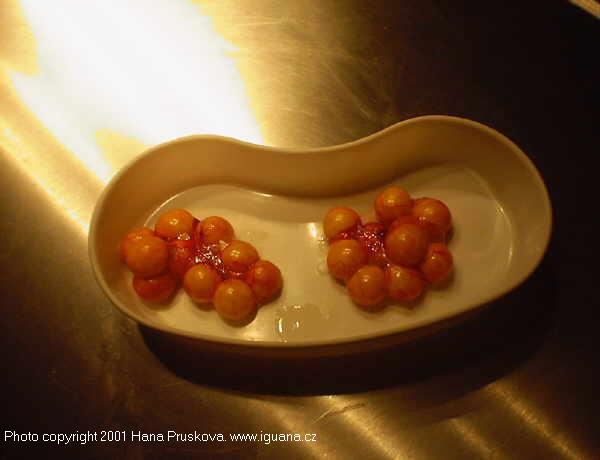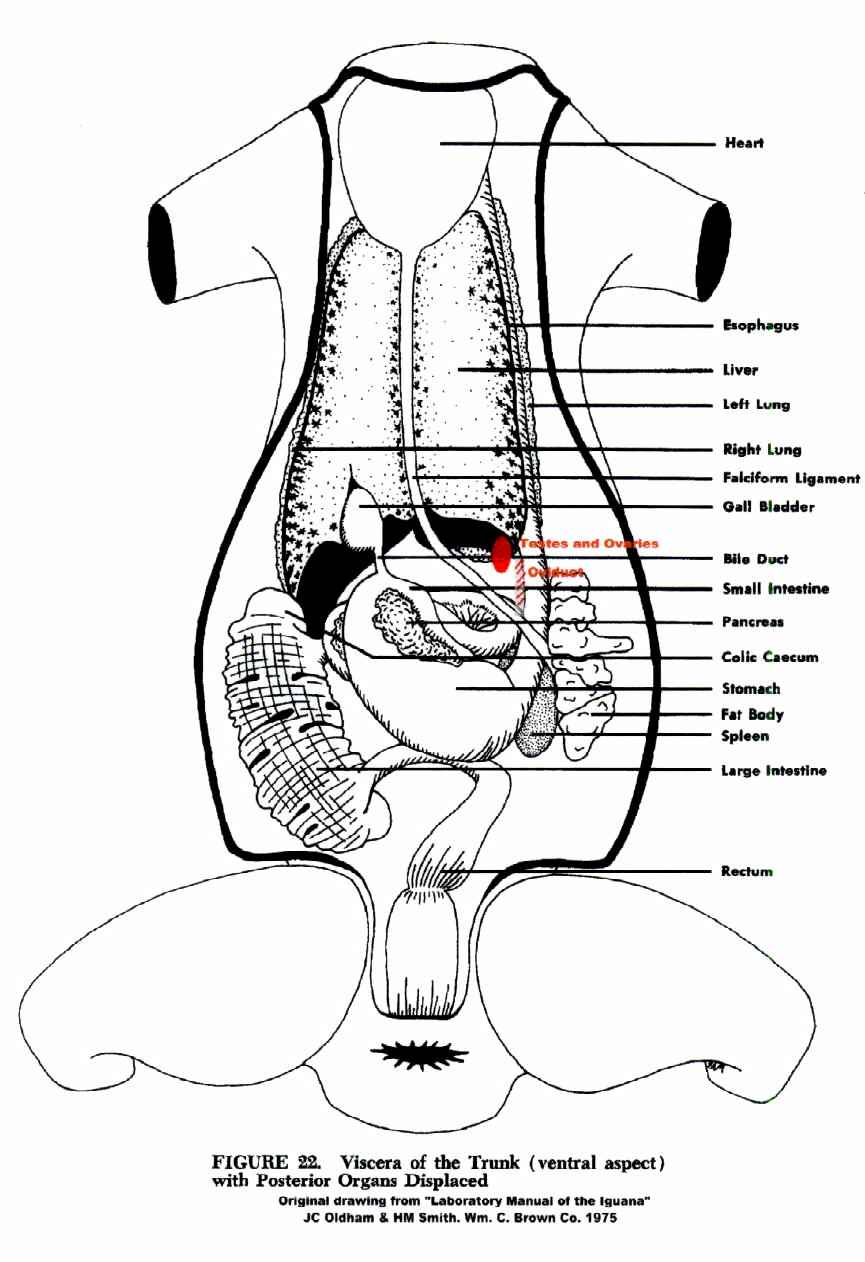
Melissa
Kaplan's
Herp Care Collection
Last updated
January 1, 2014
Iguana Ovaries and Testes
©2000 Melissa Kaplan
Germ cells, formed while the iguana is still an embryo in the egg, ultimately become either ova (eggs) or spermatozoa (sperm), depending on the sex of the iguana. During this time, the testes of the male iguana, already larger in relation to body mass than those of other animals, begin to enlarge as sperm is produced and stored.
Iguana ovaries and testes are tucked up well inside the torso of the iguana. The annotated drawing below is a little misleading as the testes and ovaries lay behind the liver, as one sees it when going into the coelomic cavity through an abdominal incision, as one does when spaying or neutering an iguana. The ovaries and testes are paired, attached by the mesovarium and mesorchium, respectively, to the left and right sides of the dorsal wall. The adrenal glands are embedded in the mesovarium and mesorchium mesentery as well.
Click on photo to see enlargement
Drawing from: Laboratory Anatomy of the Iguana, by Jonathan C. Oldham and Hobart M. Smith. 1975. Wm. C. Brown Company Publishers, Dubuque, IA
Ovaries
In females,
the ovaries are an almost insignificant dark gray mass that is nestled
up against the middorsal wall of the body cavity. Outside of breeding
season, the mass looks like a dollop of caviar. During breeding, the tiny
germ cells in the ovaries begin to enlarge. Estrogen triggers the liver
to start converting lipids in the stored body fat to vitellogenin. As
the vitellogenin is circulated through the bloodstream, the enlarging
egg follicles absorb the vitellogenin, which is stored in the ova as yolk.
Each oocyte (individual single-cell) is enclosed in its own membrane; each ovary consists of a group of oocytes contained in an overall membrane. Fertilization occurs while the early developing eggs (secondary oocytes) are still in the ovaries. After fertilization, yolk development continues (vitellogenesis), with the ova continuing to grow, until the mature ova are 10-100 times their pre-vitellogenic size (depending on species). "Ovulation" is the rupture of the individual and overall ovarian membranes as the eggs are freed from the enclosing membranes. As the egg passes through the nearby oviduct (one for each ovary), layers of fibers and proteins are applied to each egg (with each layer being applied at specific points within the oviduct), with the final layer being calcium carbonate (calcite crystals in crocodilians and squamates; aragonite crystals in turtles). The oviducts empty into the cloaca, thus eggs are shelled just before they are actually laid.

These eggs from an iguana's left and right ovaries are still in their
individual and overall ovarian membrane.
Photo by Hana Pruskova. Click
on drawing to see larger image.
Testes
Male iguanas
are fully equipped with two testes and the hemipenes,
the bi-lobed copulatory organ. The testes are inside the body, in the
same position as the ovaries, behind the liver, while the hemipenes are
tucked inside the base of the tail (which explains why male reptiles have
broader tail bases than do females of the spacies).
Male iguanas have the largest testes for their body size of all reptiles. Some keepers of sexually mature adult males don't doubt this for a second, given how their sweet Dr. Jekyll lizard becomes the raging Mr. Hyde once breeding season hits.
Iguana testes comprise 1% the male iguana's body mass. By comparison, the great apes have testes ranging in size from 0.017% to 0.269%. The great apes, then, have one-fourth as much testicular tissue, relatively speaking, as do the green iguanas. (Human males come in somewhere in the great apes range, with a 6'0" 180 pound human male having testes weighing in at about 0.041% of body weight.) Iguana keepers who have had occasion to clean up iguana ejaculate are not surprised by this datum.
Words
To Know...
The mesovarium
is that part of the mesentary that suspends each ovary from the dorsal
wall; the mesorchium is that part of the mesentary which suspends each
testes from the dorsal wall. mesorchium. The mesentary is a double layer
of peritoneum that attaches to the back wall of the abdominal cavity and
supports the small intestines.
Germ cells are the cells that are stored in the testes and ovaries which, when triggered to start growing, become either the sperm or eggs. Follicles are the enlarging ova in ovaries, prior to fertilization. Vitellogenesis is the development of the egg yolk in the follicles. Fertilization occurs when the sperm meets the ova as they pass through the oviduct, a passage which also layers the outside of the egg with calcium to form a shell. Intromission is the act of copulation, during which the male transfers his sperm into the female. Oviposition is the laying of eggs.
A Note
On Neutering
Owners of
female dogs and cats already know that spaying a female is major, albeit
fairly routine (in the sense that vets perform a lot of spays) surgical
procedure. The female is anesthetized, restrained in an open position
on her back, a lengthy abdominal incision is made, the ovaries essentially
excavated, severed and removed. When male cats and dogs are neutered,
the male is anesthetized, the scrotal sac incised, the ducts tied off,
the testes severed, and the sac stitched closed. Guess who takes longer
to heal, experiences more pain and discomfort, and takes longer to get
back to normal eating and bowel habits?
When a male iguana is neutered, the surgery is the same as a spay, as the testes are in the same position inside the body as are the female's ovaries. Since there is little evidence to support the premise that neutering seasonally aggressive sexually mature males reduces or eliminates the breeding season aggression, those thinking about neutering their male iguanas should think again...
Sources for this article include:
Burghardt, Gordon, A. Stanley Rand. 1982. Iguanas of the World: Their Behavior, Ecology and Conservation. Noyes Publishing, Park Ridge NJ.\
Mader, Douglas R. (ed.). 1996. Reptile Medicine and Surgery. WB Saunders, Philadelphia PA.
Oldham, Jonathan C. and Smith, Hobart M. 1975. Laboratory Anatomy of the Iguana. Wm. C. Crown Company Publishers, Dubuque IA.
Zug, George R. 1993. Herpetology: An introductory biology of amphibians and reptiles. Academic Press, Division of Harcourt, Brace & Company, San Diego CA.
Related Articles
Dealing with Iguana Breeding Aggression
